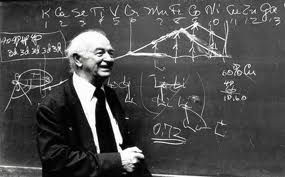
Linus Pauling
Vitamin ‘CF’ Cold Fusion
I came to know Linus Pauling in Palo Alto. I lived just a couple blocks from his office. Dr. Pauling had spoken favourably about cold fusion since it’s first announcement. He was a true judge of science and not afraid of controversy.
Being so near I walked into his office one day without any real hope of meeting him and to my surprise did. He became a mentor beyond my wildest dreams not only willing but eager to encourage me, a Palo Alto garage experimentalist, to talk through my experimental observations and ideas.
In one meeting he gave me some words of wisdom reminding me that “in his experience frequently the most remarkable discoveries almost always came unexpectedly”.
Over the course of a few years while I worked on cold fusion I was lucky enough to be able to walk to his office many times to share my observations and chat with him. Brainstorming with Linus was science to the max, an extreme sport!
I can’t quite remember, must be having a senior moment, whether it was Linus or Edward Teller who sent me around to talk with Art Schawlow another Palo Alto Nobel Laureate who was a contemporary of theirs. One thing about those guys, they were in their eighties and nineties, and though of failing flesh had incredible nimble minds. It was tough keeping up with them. It was also a privilege to be invited to do so.
What a gentle man Linus was.
Here’s some notes about Paluing’s thinking on cold fusion from the Pauling Blog..
During the years following the Fleischmann-Pons 1989 experiments and subsequent press conference, Linus Pauling’s interest on the topic of nuclear fusion, and particularly cold fusion, continued. In May 1992, while at home on his ranch in Big Sur, California, Pauling had a conversation with his grandson Barclay J. “Barky” Kamb, during which he revealed his idea for a nuclear fusion invention.
Pauling had taken note of the fact that many experiments reported a “liberation of neutrons or helions or other indication of nuclear reaction greater than the background count,” but that not all interested researchers had observed the phenomenon.
Pauling tinkered around with methods of prompting fusion with the idea to someday patenting them in the early nineties. His ideas lay fallow and a little over two years later, Pauling passed away. His notes, however, remain useful insofar as they contribute to the on-going conversation as to the possibility of cold fusion and of ways of facilitating hot fusion. Pauling’s thoughts on modern subjects such as nuclear fusion and cold fusion were also further evidence of an active and inquisitive mind even as he neared the end of his life.
Here’s an obituary from the New York Times
 |
August 21, 1994OBITUARY Linus C. Pauling Dies at 93; Chemist and Voice for PeaceBy RICHARD SEVEROLinus C. Pauling, a brilliant chemist and an untiring political activist who received one Nobel Prize for chemistry and another for peace, died on Friday at his ranch in the Big Sur area of Northern California. He was 93. The cause was cancer, said Steve Lawson, chief executive officer of the Linus Pauling Institute of Science and Medicine in Palo Alto, Calif. Dr. Pauling received the prize for chemistry in 1954, as a result of his research into the nature of the chemical bond, the force that gives atoms the cohesiveness to form the molecules that in turn become the basis of all physical matter. In 1962, at age 61, he received the Nobel Peace Prize. The award’s citation acclaimed him for his work since 1946 “not only against the testing of nuclear weapons, not only against the spread of these armaments, not only against their very use, but against all warfare as a means of solving international conflicts.” |